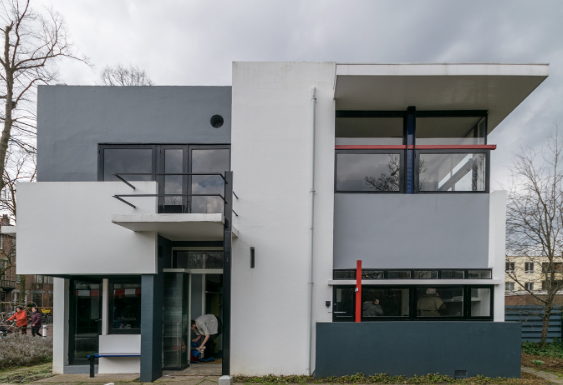The Rietveld Schröder House, nestled in Utrecht, Netherlands, stands as a testament to avant-garde architectural innovation and a milestone in the evolution of modernist design.
Architectural Significance of the Rietveld Schröder House
Historical Context and Design Philosophy
Inaugurated in 1924, the Rietveld Schröder House was a collaborative vision between architect Gerrit Rietveld and Truus Schröder-Schräder, marking a departure from conventional architectural norms towards functionalism and spatial experimentation.
UNESCO World Heritage Status
In 2000, UNESCO bestowed World Heritage status upon the Rietveld Schröder House, recognizing its pivotal role in the development of modern architecture and its enduring cultural significance.
Architectural Features of the Rietveld Schröder House
De Stijl Movement Influence
Drawing from the De Stijl movement, the house embodies principles of geometric abstraction and visual harmony, emphasizing asymmetry, straight lines, and a reductionist approach to form.
Geometric Abstraction and Minimalism
Rietveld’s design philosophy rejected ornamentation in favor of geometric purity, creating a visual language that resonates with modernist ideals of simplicity and clarity.
Use of Primary Colors and Rectilinear Forms
The integration of primary colors—red, blue, yellow—applied in bold, orthogonal planes accentuates the house’s geometric volumes, evoking a dynamic interplay between space and color.
Spatial Design and Functionality
Flexible Interior Spaces
Characterized by sliding panels and movable partitions, the interior of the Rietveld Schröder House adapts seamlessly to changing spatial needs, exemplifying a forward-thinking approach to domestic architecture.
Transformable Walls and Furniture
Innovative furniture designs, such as the iconic Red and Blue Chair, and sliding walls enable multifunctional use of space, blurring distinctions between living areas and challenging traditional room configurations.
Integration of Open and Closed Spaces
The house blurs boundaries between indoors and outdoors through expansive windows and balconies, fostering a sense of spatial continuity and inviting natural light to permeate its interior.
Innovative Use of Materials and Technology
Incorporation of Modern Materials
Rietveld employed industrial materials like steel for structural integrity, concrete for stability, and expansive glass panels to create a seamless transition between interior and exterior environments.
Steel, Concrete, and Glass
The integration of these materials not only contributed to the house’s aesthetic appeal but also facilitated Rietveld’s vision of open, airy spaces that prioritize functionality and modern living.
Technological Innovations in 1920s Architecture
Embracing prefabrication techniques and modular construction methods, Rietveld pushed the boundaries of architectural feasibility, pioneering new ways to conceptualize and construct residential spaces.
Gerrit Rietveld: Architect and Designer
Background and Influences
Trained initially as a cabinetmaker, Rietveld’s background in craftsmanship informed his meticulous attention to detail and innovative approach to furniture and architectural design.
Other Notable Works
Beyond the Rietveld Schröder House, Rietveld’s portfolio includes iconic furniture pieces and architectural commissions that continue to influence contemporary design trends and architectural discourse.
Restoration and Preservation Efforts
Challenges in Maintaining Authenticity
Preserving the authenticity of the Rietveld Schröder House poses challenges in balancing conservation efforts with evolving standards of structural integrity and visitor accessibility.
Conservation Strategies and Techniques
Ongoing conservation initiatives focus on stabilizing original materials, restoring color schemes, and maintaining the spatial integrity of Rietveld’s architectural masterpiece for future generations to appreciate.
Visitor Experience and Educational Role
Guided Tours and Public Access
The Rietveld Schröder House offers guided tours, providing visitors with an immersive experience into the visionary world of modernist architecture and Rietveld’s groundbreaking design principles.
Educational Programs and Workshops
Educational workshops and programs delve into the historical context of the house, exploring its impact on modern architecture and its relevance in contemporary design education.
Legacy and Influence on Modern Architecture
Impact on 20th Century Architecture
The Rietveld Schröder House’s radical departure from traditional architectural norms continues to inspire architects worldwide, shaping the evolution of 20th-century architectural theory and practice.
Contemporary Relevance and Inspirations
Its enduring legacy lies in its ability to provoke discourse on spatial efficiency, aesthetic purity, and the harmonious integration of form and function in contemporary architectural design.
Conclusion
Recap of the Rietveld Schröder House’s Architectural Importance
As a paragon of modernist design, the Rietveld Schröder House remains a beacon of architectural innovation and cultural heritage, celebrated for its revolutionary approach to space, materials, and aesthetics.
Continuing Legacy in Architectural Discourse
Its designation as a UNESCO World Heritage site underscores its significance in preserving architectural history and inspiring future generations to push boundaries in architectural creativity and innovation.
